With winter on the way, you may be missing walking outdoors in warmer weather. If you can still walk outdoors, enjoy it! If not, bring the outdoors in for a life science lesson or two with The Walking Classroom. You can walk, listen, and learn, then enjoy a follow-up activity like a quick read-aloud!
Environmental Escapades and More
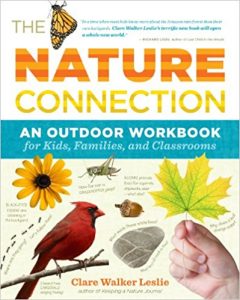 Have a listen to Conservation (5-#7, STEM-#36, Combined-#129), and follow up by taking a pick from a plethora of kids’ books on the environment. For some interesting outdoor activities to support your environmental studies, check out The Nature Connection: An Outdoor Workbook for Kids, Families, and Classrooms by Clare Walker Leslie. This activity-laden book will inspire you and your crew to get in touch with your environment and take some outdoor adventures of your own!
Have a listen to Conservation (5-#7, STEM-#36, Combined-#129), and follow up by taking a pick from a plethora of kids’ books on the environment. For some interesting outdoor activities to support your environmental studies, check out The Nature Connection: An Outdoor Workbook for Kids, Families, and Classrooms by Clare Walker Leslie. This activity-laden book will inspire you and your crew to get in touch with your environment and take some outdoor adventures of your own!
Go cross-curricular! Read a middle grades novel with environmental implications, like Carl Hiaasen’s Hoot (760L) or Scat (810L). Or try one of Jean Craighead George’s eco-mysteries, like The Missing Gator of Gumbo Limbo (740L) or The Fire Bug Connection (710L).
Perhaps you’re looking to walk, listen, and learn about Food Chains (4-#42, STEM-#33). Engage your students with some visuals! Have a look at a picture book or two on the topic. Who Eats What? Food Chains and Food Webs (620L) by Patricia Lauber might be a good place to start!
You can also learn all about Animal Classification (4-#41, STEM-#32, Combined-#131). Find out how animals are grouped and named, by having a look at Classification of Animals (820L) by Casey Rand or Animal Classification (780L) by Angela Royston. Or break your crew into small teams to explore different animal groups, by using one of the books in Royston’s Animal Classifications series (590L). These six slim books — Amphibians, Birds, Fish, Mammals, Reptiles, and Invertebrates — present vivid photographs of animals from each group and their characteristics too!
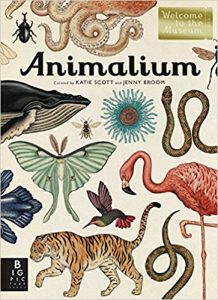 For an illustrated (rather than photographic) take on the topic, check out Jenny Broom’s Animalium, illustrated by Katie Scott. One of several titles in the pair’s Welcome to the Museum series, this oversized book makes you feel like you’re actually visiting a natural history museum, with its vintage looking drawings!
For an illustrated (rather than photographic) take on the topic, check out Jenny Broom’s Animalium, illustrated by Katie Scott. One of several titles in the pair’s Welcome to the Museum series, this oversized book makes you feel like you’re actually visiting a natural history museum, with its vintage looking drawings!
Famous Folks
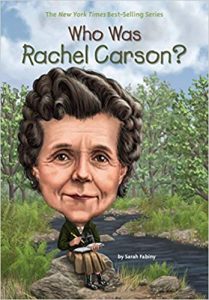 Find out about some famous folks working in life science by pairing a podcast with a book or two. Introduce your crew to Rachel Carson (5-#8, STEM-#37, Combined-#157). Follow up with your choice of a chapter book biography or look over Who Was Rachel Carson? (930L) by Sarah Fabiny. For a different experience, explore the award winning picture book, Rachel Carson and her Book that Changed the World (890L) by Laurie Lawlor and Laura Beingessner.
Find out about some famous folks working in life science by pairing a podcast with a book or two. Introduce your crew to Rachel Carson (5-#8, STEM-#37, Combined-#157). Follow up with your choice of a chapter book biography or look over Who Was Rachel Carson? (930L) by Sarah Fabiny. For a different experience, explore the award winning picture book, Rachel Carson and her Book that Changed the World (890L) by Laurie Lawlor and Laura Beingessner.
Study the life and work of John Muir (5-#12, STEM-#23, Combined-#166). Then check out Montrew Dunman’s John Muir: Young Naturalist (890L), or John Muir: America’s First Environmentalist (1050L) by Kathryn Lasky. Illustrated by Stan Fellows, the latter incorporates quotes from Muir’s diaries.
Jump back a little further in time to meet George Washington Carver (5-#29, STEM-#35, Combined-#158). Support your studies with one of several books, geared to different levels.
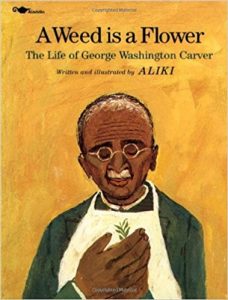 A Weed is a Flower: The Life of George Washington Carver (640L), written and illustrated by Aliki
A Weed is a Flower: The Life of George Washington Carver (640L), written and illustrated by Aliki- In the Garden with Dr. Carver (810L), written by Susan Grigsby and illustrated by Nicole Tadgell
- Who Was George Washington Carver? (910L), written by Jim Gigliotti (910L)
Making a Career of It
You can even investigate careers in life science by checking out a podcast or two in The Walking Classroom’s Science Career Series. These podcasts are easily accessible, either via our website or on WalkKits in three of The Walking Classroom’s program offerings.
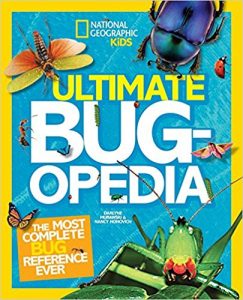 Meet entomologists Dr. Colin Brammer (4-#92, 5-#98, STEM-#52) and Dr. Jason Cryan (4-#94, 5-#100, STEM-#53). Afterward, compare the two or compare a bug or two! Use Big Book of Bugs (920L), an oversized book full of amazing photos, facts, and figures. Or take a peek into Ultimate Bugopedia: The Most Complete Bug Reference Ever (1010L) by Darlene Murawski and Nancy Honovich.
Meet entomologists Dr. Colin Brammer (4-#92, 5-#98, STEM-#52) and Dr. Jason Cryan (4-#94, 5-#100, STEM-#53). Afterward, compare the two or compare a bug or two! Use Big Book of Bugs (920L), an oversized book full of amazing photos, facts, and figures. Or take a peek into Ultimate Bugopedia: The Most Complete Bug Reference Ever (1010L) by Darlene Murawski and Nancy Honovich.
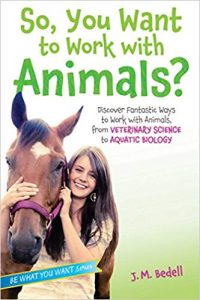 Is your crew interested in larger animals? You can learn about careers in animal science with a look at So, You Want to Work with Animals? (1090L) by J. M. Bedell. Then, encounter mammologist Dr. Stephanie Schuttler (4-#101, 5-#107, STEM-#57) or veterinarian Dr. Dan Dombroski (4-#95, 5-#101, STEM-#54) via podcast!
Is your crew interested in larger animals? You can learn about careers in animal science with a look at So, You Want to Work with Animals? (1090L) by J. M. Bedell. Then, encounter mammologist Dr. Stephanie Schuttler (4-#101, 5-#107, STEM-#57) or veterinarian Dr. Dan Dombroski (4-#95, 5-#101, STEM-#54) via podcast!
Wrap up your explorations with an activity! Zoology for Kids: Understanding and Working with Animals, with 21 Activities by Josh and Bethanie Hestermann (1190L) can provide you with an idea or two.
And, be sure to be on the lookout for the next post in our Literary Links series. We’ll have some suggestions to partner with other Walking Classroom podcasts.


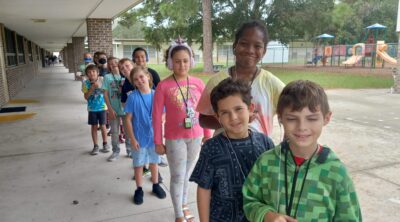


Leave a Reply